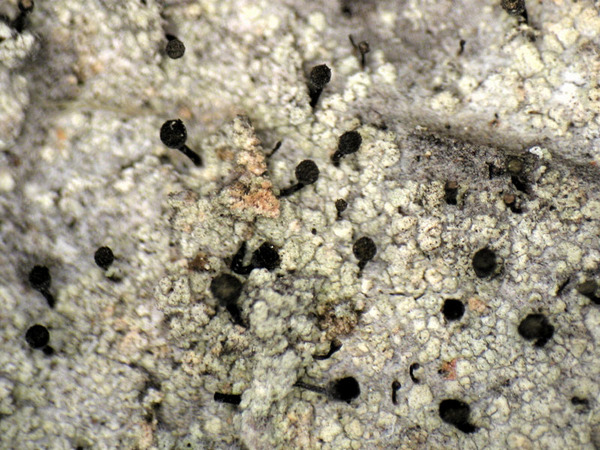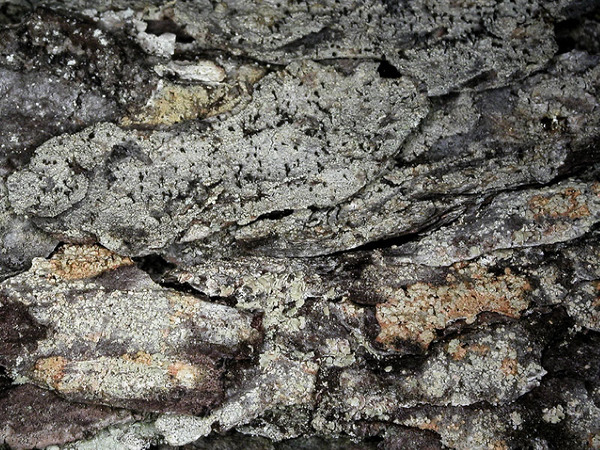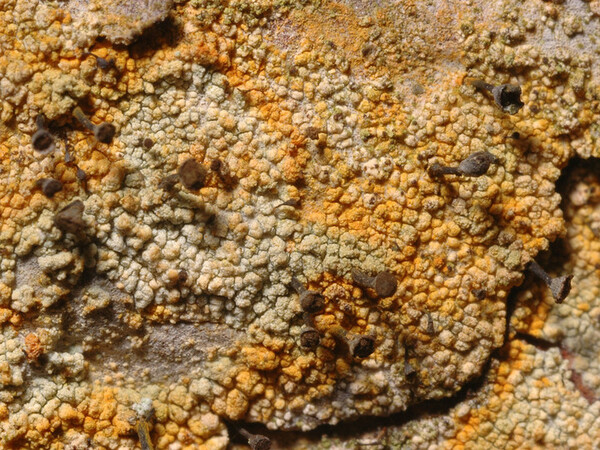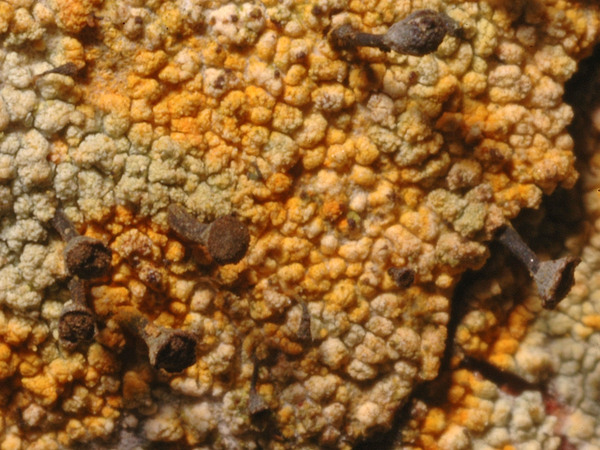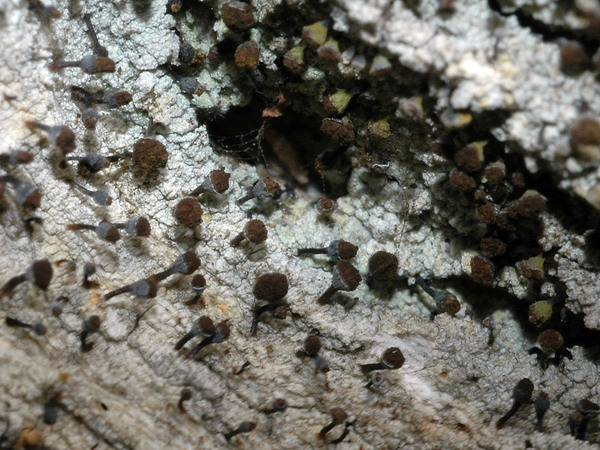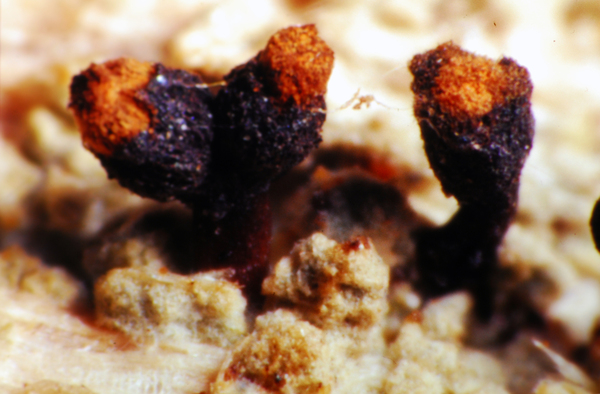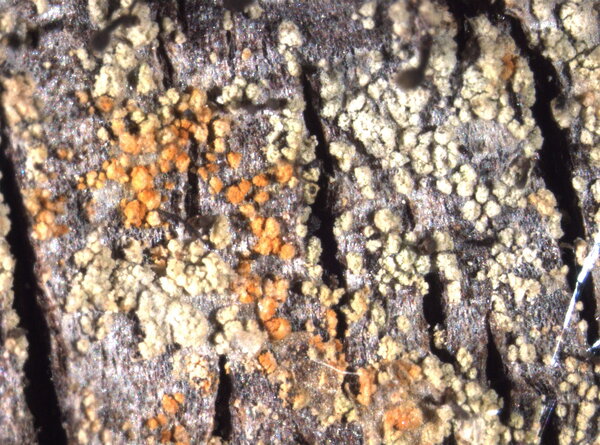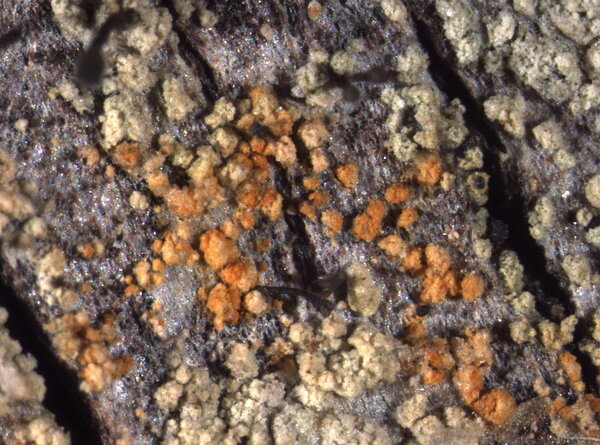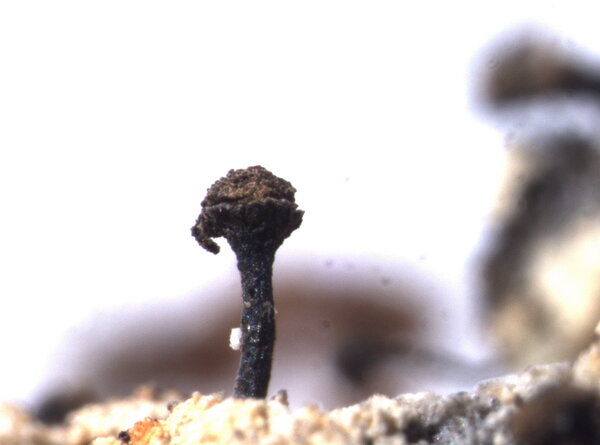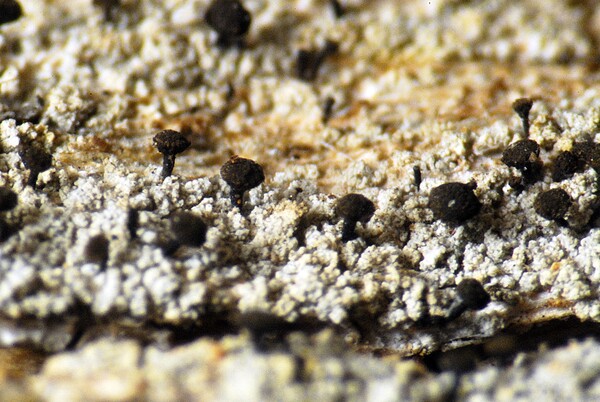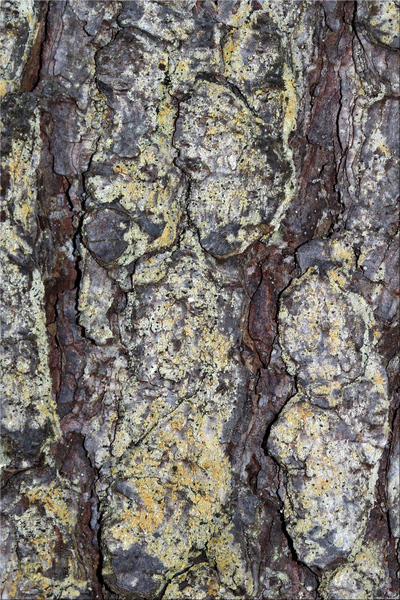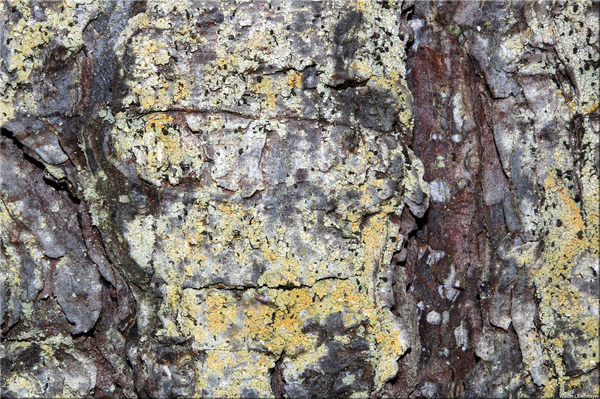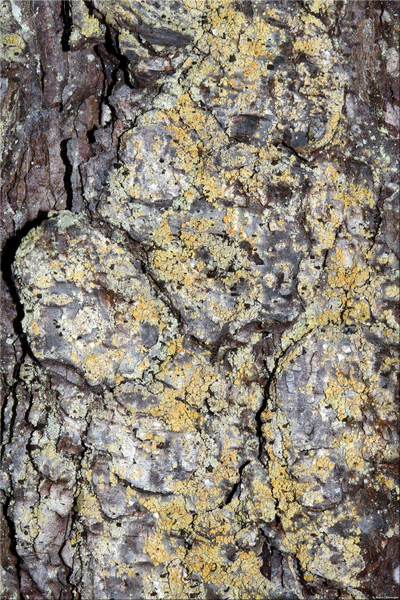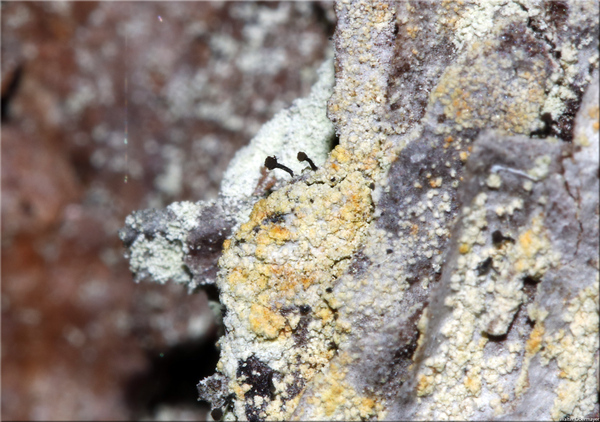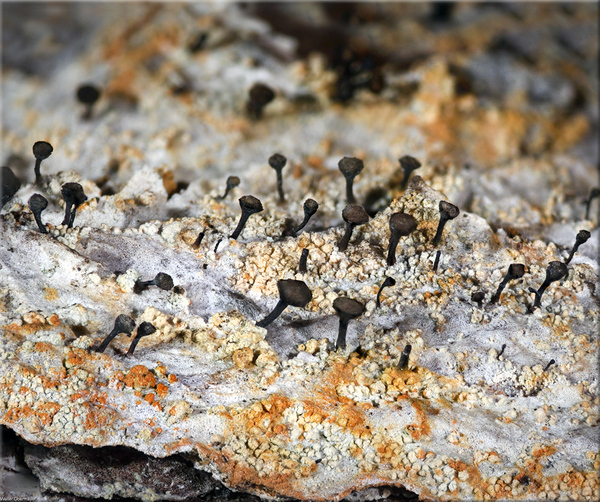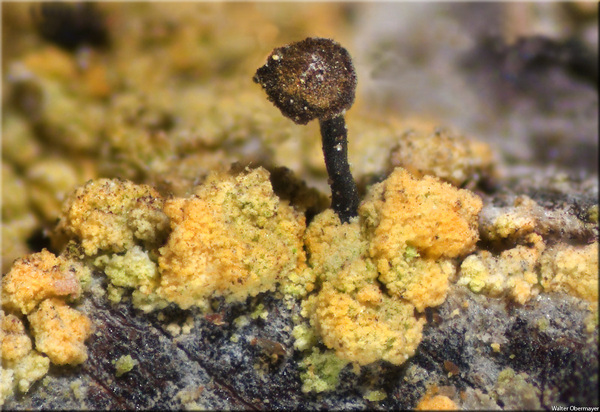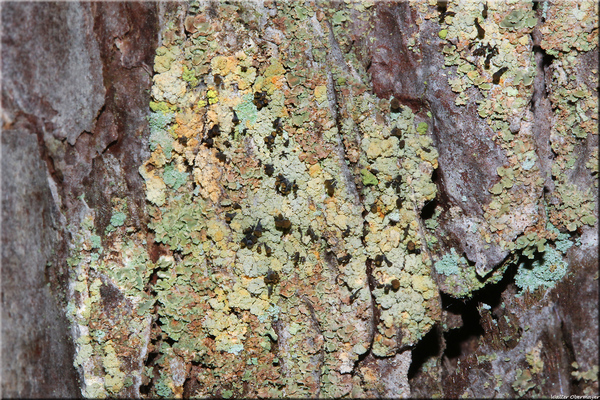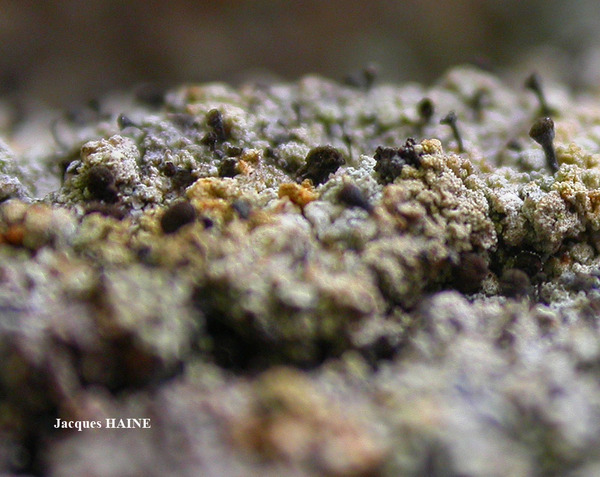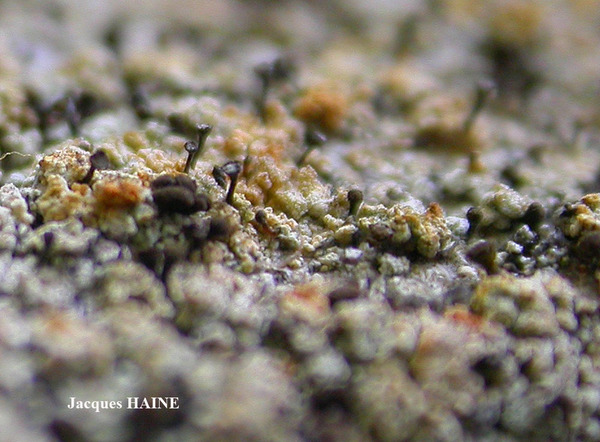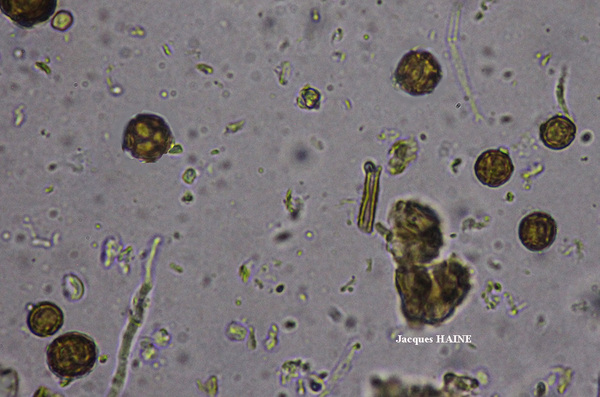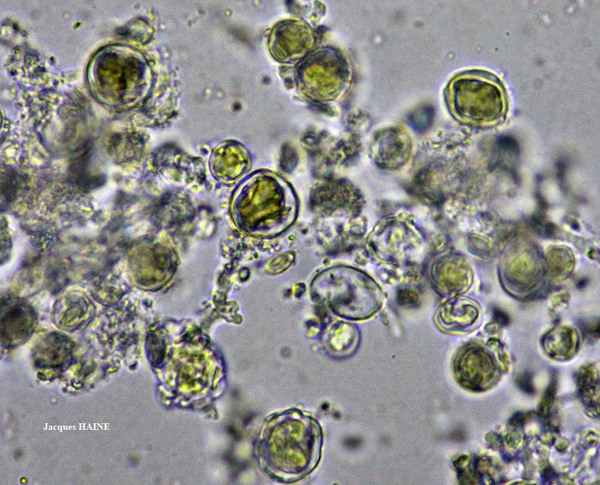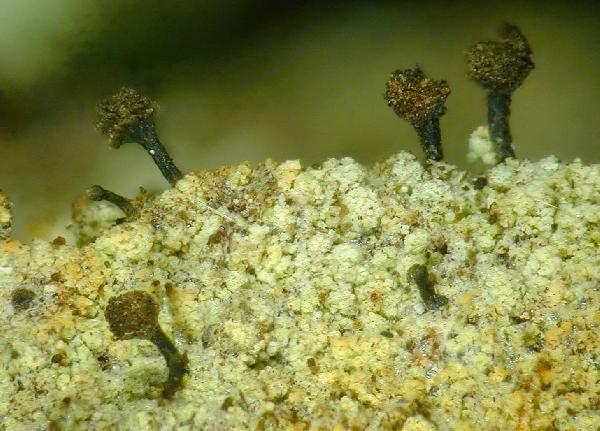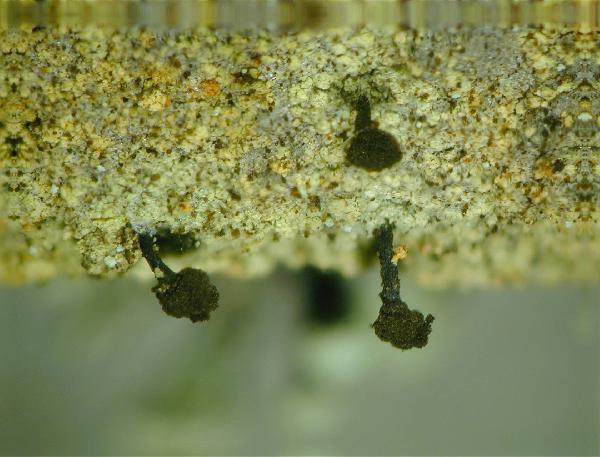Chaenotheca ferruginea (Sm.) Mig.
Kryptogamenfl. Deutschl., Deutsch-Österr., Schweiz, 4, Flechten, 2: 479, 1931. Basionym: Calicium ferrugineum Turner ex Sm. in Smith & Sowerby - Engl. Bot., 35: 2473, 1812.
Synonyms: Calicium melanophaeum Ach.; Calicium roscidum (Ach.) Flörke var. pinastri Ach.; Chaenotheca melanophaea (Ach.) Zwackh; Cyphelium melanophaeum (Ach.) Körb.; Cyphelium melanophaeum var. ferrugineum (Sm.) A. Massal.; Cyphelium melanophaeum var. vulgare (Schaer.) Körb.
Distribution: N - VG (Carvalho 1997), Frl (Puntillo & Puntillo 2009), Ven (Nascimbene & Caniglia 2000, Nascimbene 2005c, 2008c, Nascimbene & al. 2006e, 2013b, Nascimbene & Marini 2007), TAA (Nascimbene 2005b, 2006c, 2008b, 2013, 2014, Puntillo & Puntillo 2009, Nascimbene & al. 2007b, 2009, 2010, 2014, 2022, Nascimbene & Marini 2015, Nimis & al. 2015, Trindade & al. 2021), Lomb (Dalle Vedove & al. 2004, Puntillo & Puntillo 2009), Piem (Isocrono & al. 2004, Puntillo & Puntillo 2009, Ravera & al. 2025b), Emil (Brunialti & al. 2001, Tretiach & al. 2008), VA (Puntillo & Puntillo 2018), Lig (Puntillo & Puntillo 2009, Giordani & al. 2025). C - Tosc (Loppi & Putortì 1995b, Puntillo & Puntillo 2009), Umb (Genovesi & al. 2001, Ravera & al. 2006, Puntillo & Puntillo 2009), Laz (Ravera 2001, Puntillo & Puntillo 2009), Sar (Rizzi & al. 2011, Di Nuzzo & al. 2022). S - Bas (Puntillo & al. 2012), Cal (Puntillo 1994, 1996, Puntillo & Puntillo 2009).
Description: Thallus crustose, usually episubstratic, ecorticate, granular-verrucose, sometimes patchily sorediate, pale whitish grey to pale green, often with yellow-orange to rusty red patches which may extend over most of the thallus, rarely immersed and inconspicuous. Apothecia rather frequent, on long stalks, pin-like, (0.4-)1-2 mm tall, 5-15 times as long as width of stalk; stalk 70-150 µm thick, shiny black, epruinose; capitulum broadly to narrowly obconical, 0.2-0.5 mm across, the mazaedium pale to dark brown, often with a yellow tinge. Exciple well-developed, epruinose consisting of numerous layers of interwoven but largely periclinally arranged hyphae; hypothecium obconical, medium brown, with a convex upper surface. Asci cylindrical to narrowly clavate, distinctly stalked, formed singly or in short chains, disintegrating early, with uni- to biseriately arranged spores. Ascospores 1-celled, dark brown, globose, 5.5-8 μm wide, thick-walled, coarsely and irregularly fissured at maturity. Photobiont chlorococcoid (Trebouxia). Spot tests: thallus K-, C-, KC, P-, except the pigmented parts, which react K+ deep red; ascospore mass with a yellowish, K+ red pigment. Chemistry: a quinoid pigment. Note: a cool-temperate to boreal-montane, circumboreal species found on acid bark, especially of very old oaks, Castanea and conifers, on faces protected from rain, sometimes on decorticated stumps and even charred wood, reported as tolerant of air pollution and expanding in northern Europe, but rare and bound to natural habitats throughout Italy.
Growth form: Crustose
Substrata: bark
Photobiont: green algae other than Trentepohlia
Reproductive strategy: mainly sexual
Subcontinental: restricted to areas with a dry-subcontinental climate (e.g. dry Alpine valleys, parts of Mediterranean Italy)
In underhangs rarely wetted by rain
Commonnes-rarity: (info)
Alpine belt: absent
Subalpine belt: absent
Oromediterranean belt: absent
Montane belt: extremely rare
Submediterranean belt: extremely rare
Padanian area: absent
Humid submediterranean belt: very rare
Humid mediterranean belt: absent
Dry mediterranean belt: absent
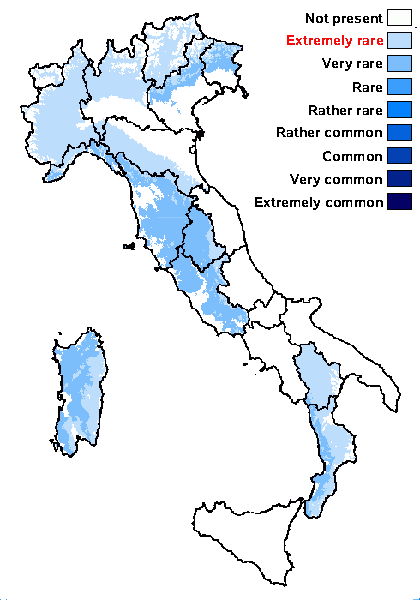
Predictive model
Herbarium samples

Ulrich Kirschbaum CC BY-SA 4.0 - Source: https://www.thm.de/lse/ulrich-kirschbaum/flechtenbilder
Central Europe; Germany: Hesse.
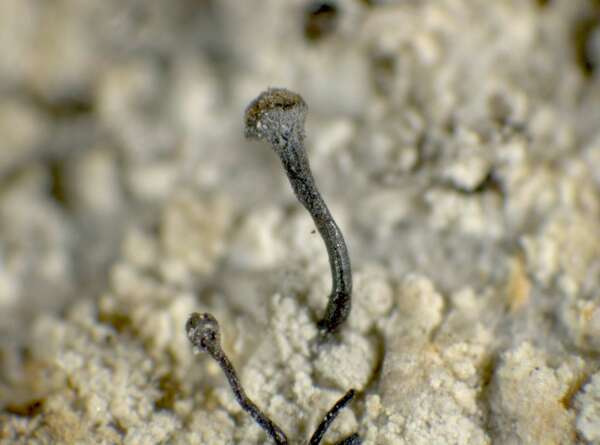

P.L. Nimis; Owner: Department of Life Sciences, University of Trieste
Herbarium: TSB (11503)
2001/12/05


Juri Nascimbene – CC BY-SA 4.0; Owner: Department of ùLife Sciences, University of Trieste
Paneveggio, Trentino, Italy


P.L. Nimis; Owner: Department of Life Sciences, University of Trieste
Herbarium: TSB (34867)
2002/02/17
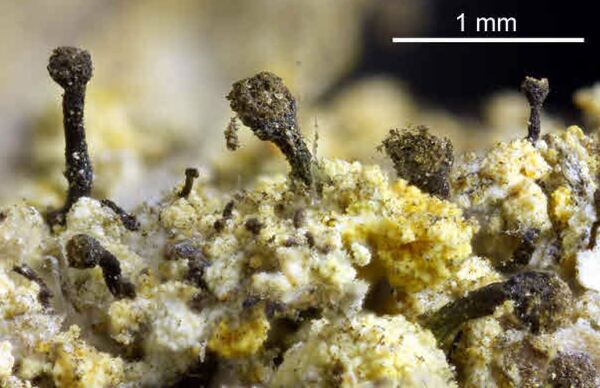

Felix Schumm – CC BY-SA 4.0
[4540], Germany, Baden-Württemberg, an Picea excelsior beim Wasserfall, ca. 360 m. Leg. Schumm 23.05.1993
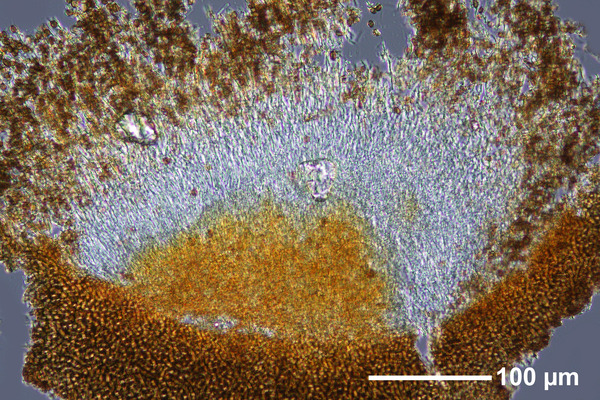

Felix Schumm – CC BY-SA 4.0
[4540], Germany, Baden-Württemberg, an Picea excelsa beim Wasserfall, ca. 360 m. Leg. Schumm 23.05.1993
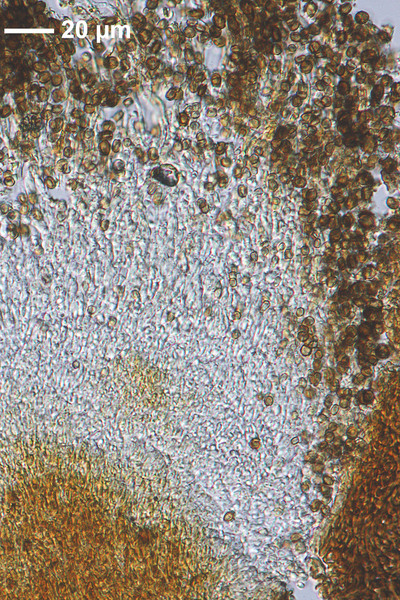

Felix Schumm – CC BY-SA 4.0
[4540], Germany, Baden-Württemberg, an Picea excelsa beim Wasserfall, ca. 360 m. Leg. Schumm 23.05.1993
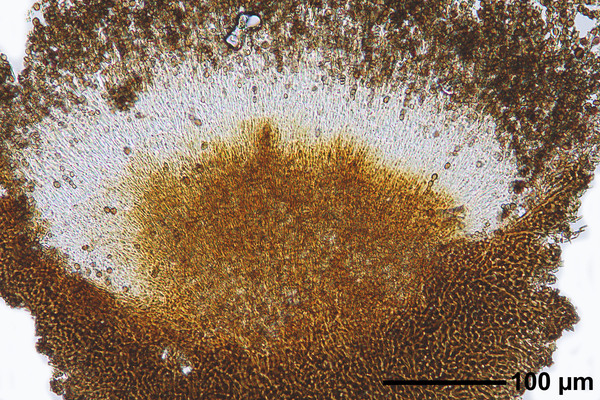

Felix Schumm – CC BY-SA 4.0
[4540], Germany, Baden-Württemberg, an Picea excelsa beim Wasserfall, ca. 360 m. Leg. Schumm 23.05.1993


Felix Schumm – CC BY-SA 4.0
[4540], Germany, Baden-Württemberg, an Picea excelsa beim Wasserfall, ca. 360 m. Leg. Schumm 23.05.1993
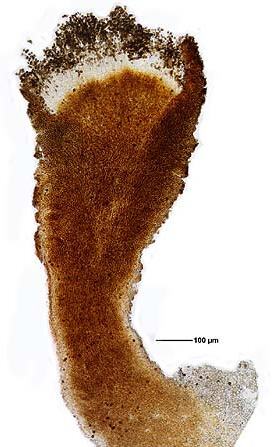

Felix Schumm – CC BY-SA 4.0
[4540], Germany, Baden-Württemberg, an Picea excelsa beim Wasserfall, ca. 360 m. Leg. Schumm 23.05.1993
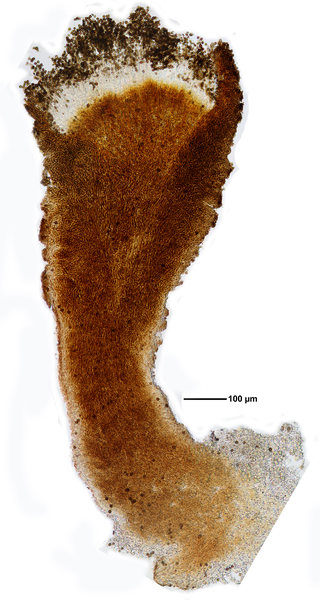

Felix Schumm – CC BY-SA 4.0
[4540], Germany, Baden-Württemberg, an Picea excelsa beim Wasserfall, ca. 360 m. Leg. Schumm 23.05.1993


Felix Schumm – CC BY-SA 4.0
[4540], Germany, Baden-Württemberg, an Picea excelsa beim Wasserfall, ca. 360 m. Leg. Schumm 23.05.1993
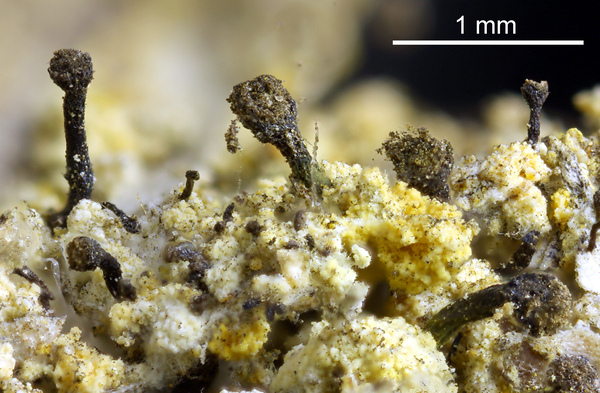

Felix Schumm – CC BY-SA 4.0
[4540], Germany, Baden-Württemberg, an Picea excelsa beim Wasserfall, ca. 360 m. Leg. Schumm 23.05.1993


Felix Schumm – CC BY-SA 4.0
[4540], Germany, Baden-Württemberg, an Picea excelsa beim Wasserfall, ca. 360 m. Leg. Schumm 23.05.1993
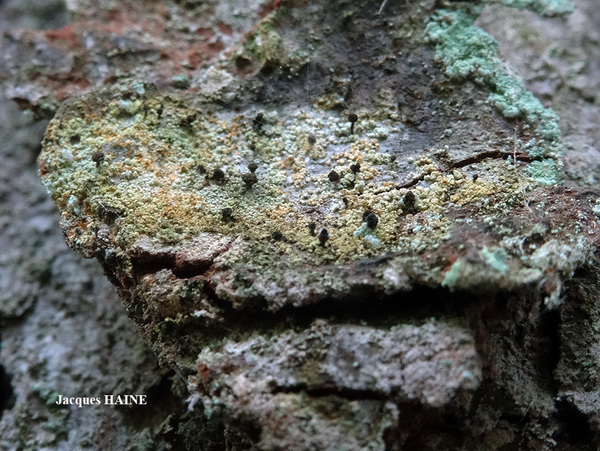
Jacquesa Haine - Source: http://www.lichensmaritimes.org/index.php?task=fiche&lichen=497&lang=en
France, Argonne
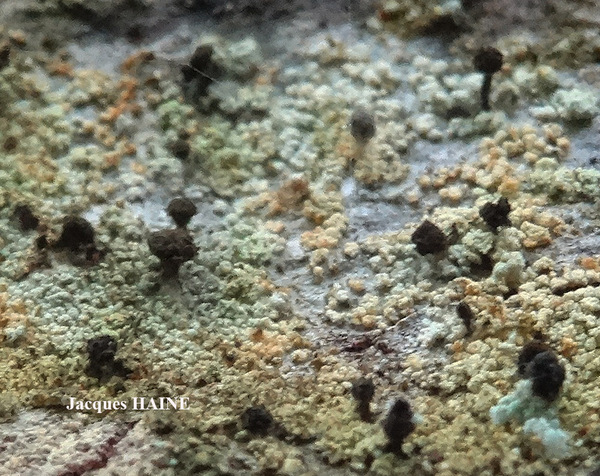
Jacquesa Haine - Source: http://www.lichensmaritimes.org/index.php?task=fiche&lichen=497&lang=en
France, Argonne
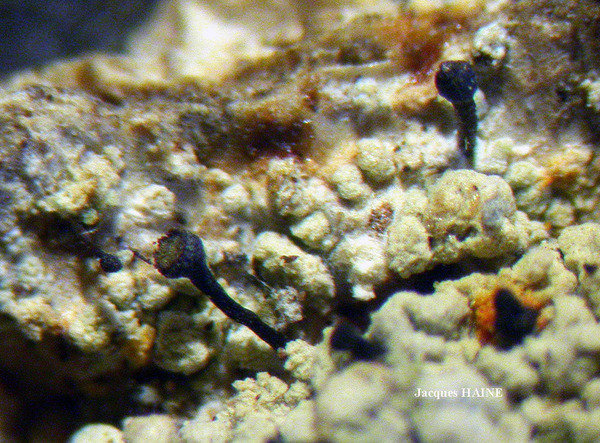
Jacquesa Haine - Source: http://www.lichensmaritimes.org/index.php?task=fiche&lichen=497&lang=en
Wallonie
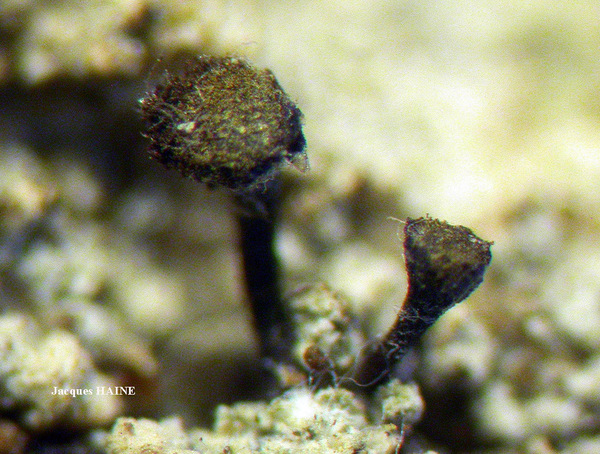
Jacquesa Haine - Source: http://www.lichensmaritimes.org/index.php?task=fiche&lichen=497&lang=en
Wallonie

Ulrich Kirschbaum CC BY-SA 4.0 - Source: https://www.thm.de/lse/ulrich-kirschbaum/flechtenbilder
Central Europe; Germany: Hesse.
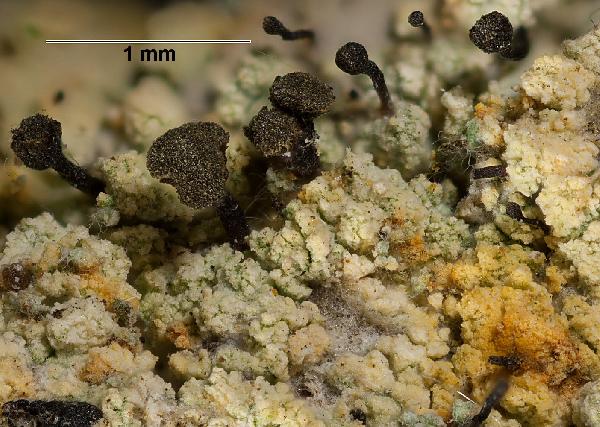
Ulrich Kirschbaum CC BY-SA 4.0 - Source: https://www.thm.de/lse/ulrich-kirschbaum/flechtenbilder
Central Europe; Germany: Hesse.
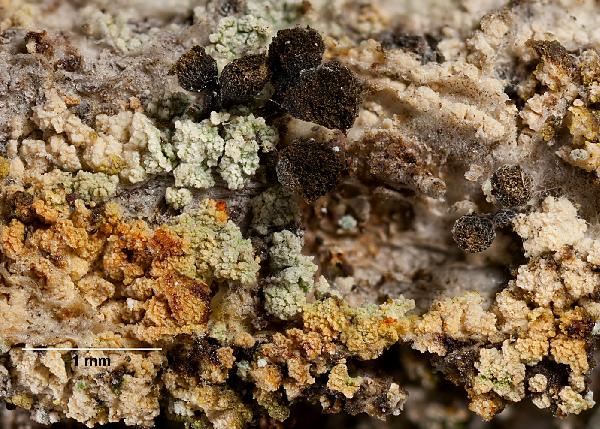
Ulrich Kirschbaum CC BY-SA 4.0 - Source: https://www.thm.de/lse/ulrich-kirschbaum/flechtenbilder
Central Europe; Germany: Hesse.
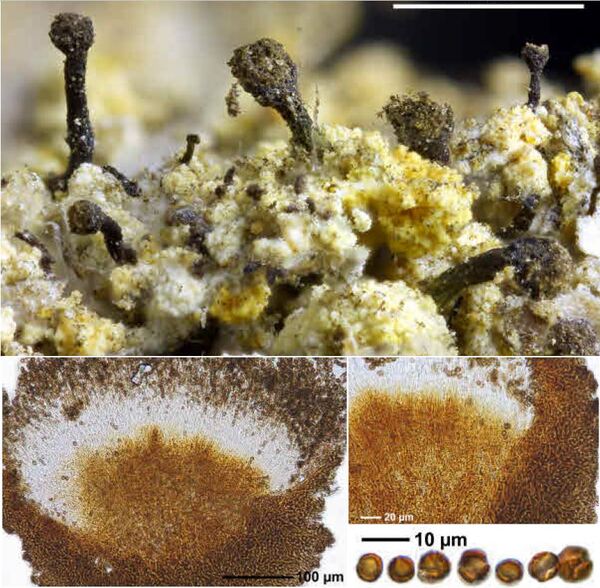

Felix Schumm – CC BY-SA 4.0
[4540], Germany, Baden-Württemberg, an Picea excelsior beim Wasserfall, ca. 360 m. Leg. Schumm 23.05.1993
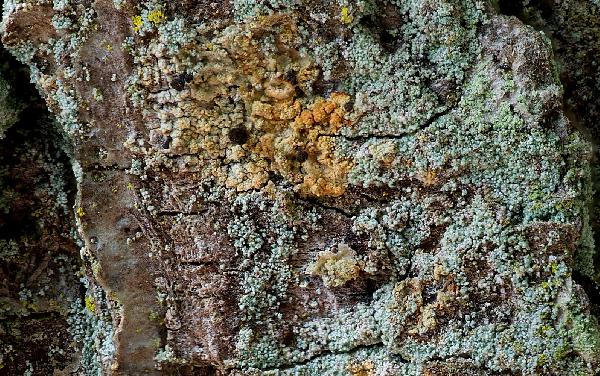
Ulrich Kirschbaum CC BY-SA 4.0 - Source: https://www.thm.de/lse/ulrich-kirschbaum/flechtenbilder
Central Europe; Germany: Hesse.
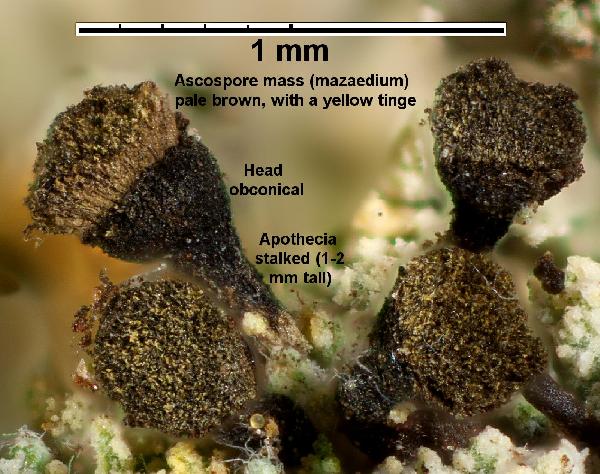
Ulrich Kirschbaum CC BY-SA 4.0 - Source: https://www.thm.de/lse/ulrich-kirschbaum/flechtenbilder
Central Europe; Germany: Hesse.

Ulrich Kirschbaum CC BY-SA 4.0 - Source: https://www.thm.de/lse/ulrich-kirschbaum/flechtenbilder
Central Europe
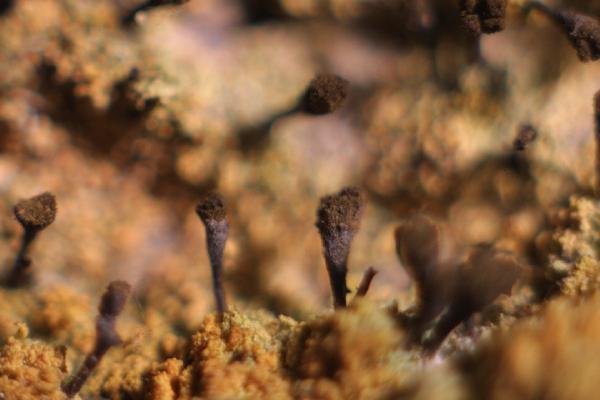

Felix Schumm - CC BY-SA 4.0
[8737], Germany, Baden-Württemberg, Rems-Murr-Kreis, an Fichten
bei Murrhardt, 48°59.370 N, 9°35.023 E, 320 m, TK: 023. Leg. F.
Schumm, 22.06.2001, det. F. Schumm 2001.
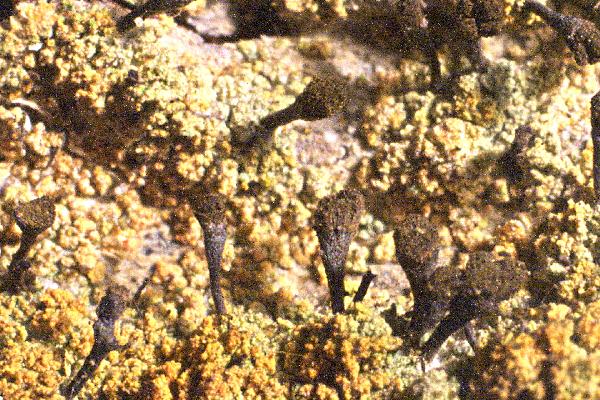

Felix Schumm - CC BY-SA 4.0
[8737], Germany, Baden-Württemberg, Rems-Murr-Kreis, an Fichten
bei Murrhardt, 48°59.370 N, 9°35.023 E, 320 m, TK: 023. Leg. F.
Schumm, 22.06.2001, det. F. Schumm 2001.
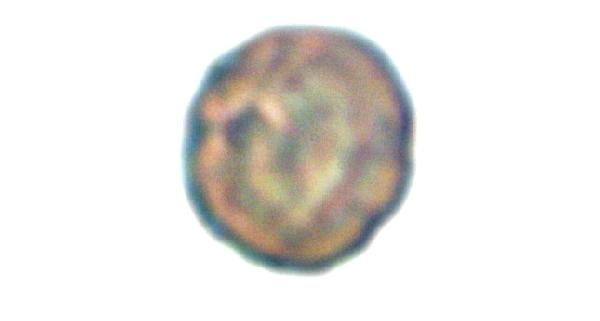

Felix Schumm - CC BY-SA 4.0
[8737], Germany, Baden-Württemberg, Rems-Murr-Kreis, an Fichten
bei Murrhardt, 48°59.370 N, 9°35.023 E, 320 m, TK: 023. Leg. F.
Schumm, 22.06.2001, det. F. Schumm 2001.
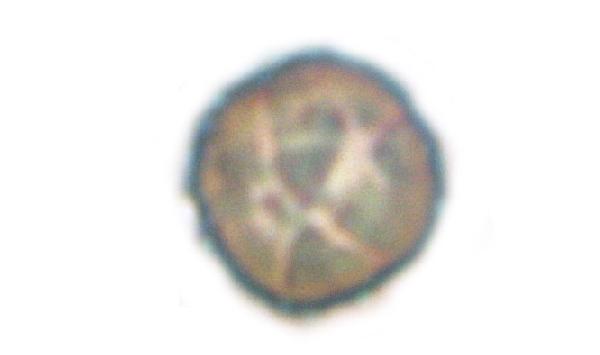

Felix Schumm - CC BY-SA 4.0
[8737], Germany, Baden-Württemberg, Rems-Murr-Kreis, an Fichten
bei Murrhardt, 48°59.370 N, 9°35.023 E, 320 m, TK: 023. Leg. F.
Schumm, 22.06.2001, det. F. Schumm 2001.
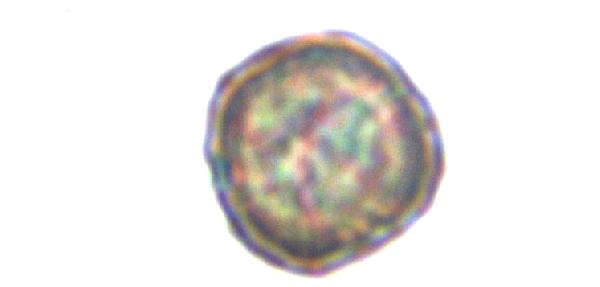

Felix Schumm - CC BY-SA 4.0
[8737], Germany, Baden-Württemberg, Rems-Murr-Kreis, an Fichten
bei Murrhardt, 48°59.370 N, 9°35.023 E, 320 m, TK: 023. Leg. F.
Schumm, 22.06.2001, det. F. Schumm 2001.
Growth form: Crustose
Substrata: bark
Photobiont: green algae other than Trentepohlia
Reproductive strategy: mainly sexual
Subcontinental: restricted to areas with a dry-subcontinental climate (e.g. dry Alpine valleys, parts of Mediterranean Italy)
In underhangs rarely wetted by rain
Commonnes-rarity: (info)
Alpine belt: absent
Subalpine belt: absent
Oromediterranean belt: absent
Montane belt: extremely rare
Submediterranean belt: extremely rare
Padanian area: absent
Humid submediterranean belt: very rare
Humid mediterranean belt: absent
Dry mediterranean belt: absent

Predictive model
| Herbarium samples |

Ulrich Kirschbaum CC BY-SA 4.0 - Source: https://www.thm.de/lse/ulrich-kirschbaum/flechtenbilder
Central Europe; Germany: Hesse.


P.L. Nimis; Owner: Department of Life Sciences, University of Trieste
Herbarium: TSB (11503)
2001/12/05


Juri Nascimbene – CC BY-SA 4.0; Owner: Department of ùLife Sciences, University of Trieste
Paneveggio, Trentino, Italy


P.L. Nimis; Owner: Department of Life Sciences, University of Trieste
Herbarium: TSB (34867)
2002/02/17


Felix Schumm – CC BY-SA 4.0
[4540], Germany, Baden-Württemberg, an Picea excelsior beim Wasserfall, ca. 360 m. Leg. Schumm 23.05.1993


Felix Schumm – CC BY-SA 4.0
[4540], Germany, Baden-Württemberg, an Picea excelsa beim Wasserfall, ca. 360 m. Leg. Schumm 23.05.1993


Felix Schumm – CC BY-SA 4.0
[4540], Germany, Baden-Württemberg, an Picea excelsa beim Wasserfall, ca. 360 m. Leg. Schumm 23.05.1993


Felix Schumm – CC BY-SA 4.0
[4540], Germany, Baden-Württemberg, an Picea excelsa beim Wasserfall, ca. 360 m. Leg. Schumm 23.05.1993


Felix Schumm – CC BY-SA 4.0
[4540], Germany, Baden-Württemberg, an Picea excelsa beim Wasserfall, ca. 360 m. Leg. Schumm 23.05.1993


Felix Schumm – CC BY-SA 4.0
[4540], Germany, Baden-Württemberg, an Picea excelsa beim Wasserfall, ca. 360 m. Leg. Schumm 23.05.1993


Felix Schumm – CC BY-SA 4.0
[4540], Germany, Baden-Württemberg, an Picea excelsa beim Wasserfall, ca. 360 m. Leg. Schumm 23.05.1993


Felix Schumm – CC BY-SA 4.0
[4540], Germany, Baden-Württemberg, an Picea excelsa beim Wasserfall, ca. 360 m. Leg. Schumm 23.05.1993


Felix Schumm – CC BY-SA 4.0
[4540], Germany, Baden-Württemberg, an Picea excelsa beim Wasserfall, ca. 360 m. Leg. Schumm 23.05.1993


Felix Schumm – CC BY-SA 4.0
[4540], Germany, Baden-Württemberg, an Picea excelsa beim Wasserfall, ca. 360 m. Leg. Schumm 23.05.1993

Jacquesa Haine - Source: http://www.lichensmaritimes.org/index.php?task=fiche&lichen=497&lang=en
France, Argonne

Jacquesa Haine - Source: http://www.lichensmaritimes.org/index.php?task=fiche&lichen=497&lang=en
France, Argonne

Jacquesa Haine - Source: http://www.lichensmaritimes.org/index.php?task=fiche&lichen=497&lang=en
Wallonie

Jacquesa Haine - Source: http://www.lichensmaritimes.org/index.php?task=fiche&lichen=497&lang=en
Wallonie

Ulrich Kirschbaum CC BY-SA 4.0 - Source: https://www.thm.de/lse/ulrich-kirschbaum/flechtenbilder
Central Europe; Germany: Hesse.

Ulrich Kirschbaum CC BY-SA 4.0 - Source: https://www.thm.de/lse/ulrich-kirschbaum/flechtenbilder
Central Europe; Germany: Hesse.

Ulrich Kirschbaum CC BY-SA 4.0 - Source: https://www.thm.de/lse/ulrich-kirschbaum/flechtenbilder
Central Europe; Germany: Hesse.


Felix Schumm – CC BY-SA 4.0
[4540], Germany, Baden-Württemberg, an Picea excelsior beim Wasserfall, ca. 360 m. Leg. Schumm 23.05.1993

Ulrich Kirschbaum CC BY-SA 4.0 - Source: https://www.thm.de/lse/ulrich-kirschbaum/flechtenbilder
Central Europe; Germany: Hesse.

Ulrich Kirschbaum CC BY-SA 4.0 - Source: https://www.thm.de/lse/ulrich-kirschbaum/flechtenbilder
Central Europe; Germany: Hesse.

Ulrich Kirschbaum CC BY-SA 4.0 - Source: https://www.thm.de/lse/ulrich-kirschbaum/flechtenbilder
Central Europe


Felix Schumm - CC BY-SA 4.0
[8737], Germany, Baden-Württemberg, Rems-Murr-Kreis, an Fichten bei Murrhardt, 48°59.370 N, 9°35.023 E, 320 m, TK: 023. Leg. F. Schumm, 22.06.2001, det. F. Schumm 2001.


Felix Schumm - CC BY-SA 4.0
[8737], Germany, Baden-Württemberg, Rems-Murr-Kreis, an Fichten bei Murrhardt, 48°59.370 N, 9°35.023 E, 320 m, TK: 023. Leg. F. Schumm, 22.06.2001, det. F. Schumm 2001.


Felix Schumm - CC BY-SA 4.0
[8737], Germany, Baden-Württemberg, Rems-Murr-Kreis, an Fichten bei Murrhardt, 48°59.370 N, 9°35.023 E, 320 m, TK: 023. Leg. F. Schumm, 22.06.2001, det. F. Schumm 2001.


Felix Schumm - CC BY-SA 4.0
[8737], Germany, Baden-Württemberg, Rems-Murr-Kreis, an Fichten bei Murrhardt, 48°59.370 N, 9°35.023 E, 320 m, TK: 023. Leg. F. Schumm, 22.06.2001, det. F. Schumm 2001.


 INDEX FUNGORUM
INDEX FUNGORUM
 GBIF
GBIF
 DOLICHENS
DOLICHENS
